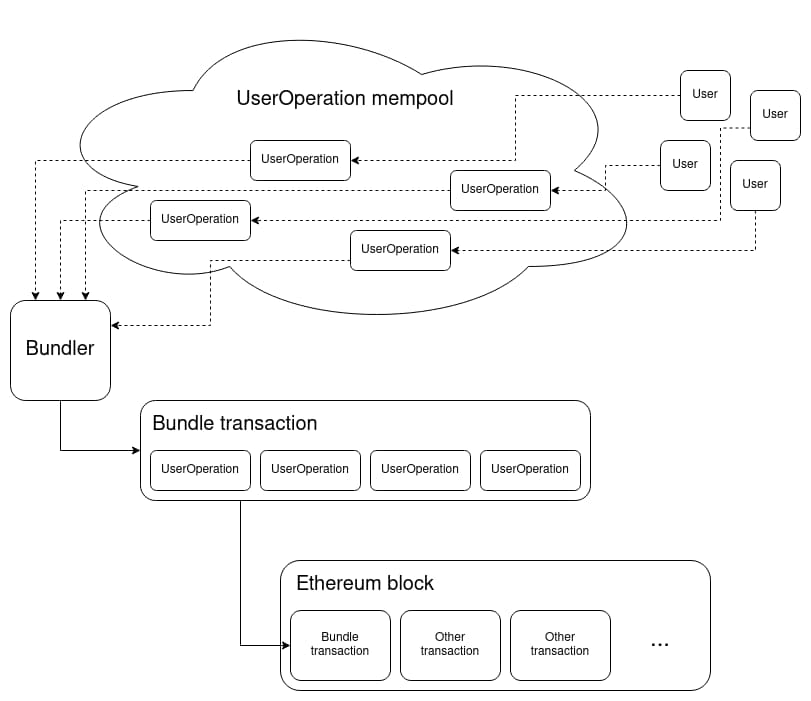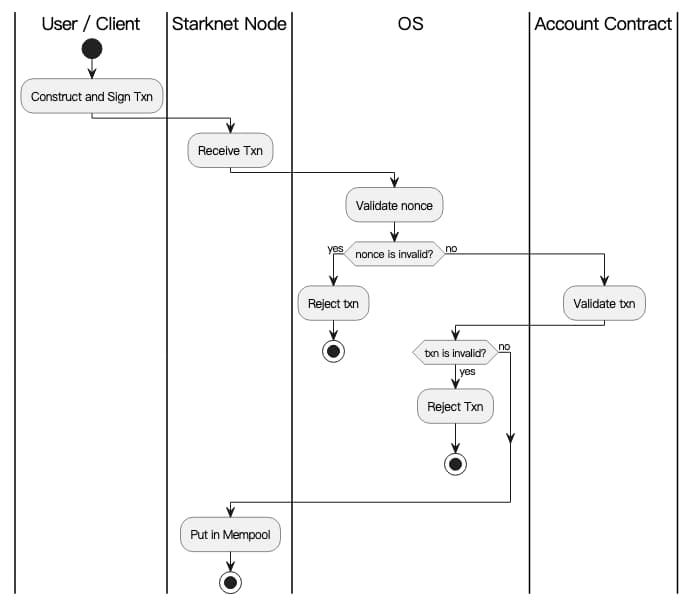After L2 technology dynamically presented "short-term OP, long-term ZK", Vitalik's mind began to tilt towards account abstraction (Account Abstraction) technology. At this Ethereum Developers Conference in Bogota, he also made a speech for Soul wallet, a wallet that supports account abstraction technology. Like, attract attention.
Account abstraction can reduce transaction data from the source, combined with the Rollup solution, it can be used as an integrated "data thinning" solution, which can greatly reduce the consumption and use of Gas Fee, and an easy-to-use and cheap Ethereum network will appear in the world.
On October 3, Vitalik supplemented the content of the EIP-4337 account abstraction proposal, adding the data aggregation part of the BLS signature algorithm, which allows builders and batch verifiers to aggregate signatures to reduce the data broadcast to the main network.
Moreover, StarkNet also proposes a detailed design of account abstraction in the new version update. The DoS crisis that plagued account abstraction has also been resolved as more Zk-based Rollups are put into use. The security of the ZK scheme has not received the same attention as the data compression feature. This is a feature that has been neglected for a long time in the past. The dispute over the abstract route has been displayed in an all-round way.
first level title
Change of thinking: account abstraction in non-consensus layer

In this update, the account abstract model is designed through the EIP proposal. In the original idea, it was originally hoped to change the account address design of Ethereum itself and unify the EOA account and smart contract address. This is also the original idea. Ethereum account address design scheme.
Among the proposals before 4337, such as EIP-86/208, EIP-859, and EIP-2938, these proposals have some common features, and they are basically based on the Ethereum mainnet. In an environment where it has been adopted, it is too risky to rashly carry out operations like “severing muscles and bones” on the main network. In fact, the priority of account abstraction is placed after L2.
This is not the optimal solution in terms of engineering, but adhering to the principle of "it's not impossible to use", the real implementation of account abstraction needs to wait for the L2 solution, especially the practical application of the ZK route.
In essence, the functions that the account abstraction wants to achieve can be realized through the EOA account + smart contract at present, which does not affect the Ethereum main network. The community only wants an "improvement", not an overthrow.
first level title
Smart contract: ERC-4337 standard dominates the world
As mentioned above, there are two types of addresses on Ethereum, EOA external account address and smart contract address. Among them, EOA controls the interaction between "humans" and Ethereum. For example, private keys, mnemonics, ETH (Gas Fee ) and other preconditions; while the smart contract address is a pre-written function that performs specific tasks under specific conditions.
The two cooperate with each other to create the most abundant Ethereum ecology, and concepts such as mnemonic words, wallets, private keys, and smart contracts are also deeply rooted in the hearts of the people, but in fact this is not the optimal solution for Ethereum, and maintaining two sets of address types will reduce the The operating efficiency of the main network, for example, requires additional overhead to determine what type of address an address belongs to, not to mention that complex operations will require expensive Gas Fee.
Therefore, since 2015, we have been constantly seeking to combine the two. The current 4337 proposal is the closest to a successful scheme design. "Intelligence" to unify the two, instead of modifying the main network at the consensus layer level, in order to strike a balance between security and efficiency.

Users are expected to send off-chain information called User Operations, which are collected and batched into a batch by block builders. Builders are responsible for filtering these actions to ensure they only accept actions that pay a fee. And there is a separate Mempool for user operations, and nodes connected to this Mempool perform ERC-4337-specific verification to ensure that user operations are guaranteed to pay fees before being forwarded.
The benefits of doing this are as follows:
Smarter. The logical nature of smart contracts will provide the possibility for more complex operations;
safer. The wallet can have built-in multi-signature function and social recovery function to get rid of mnemonic words.
more flexible. For example, it can realize sponsorship transactions by others, avoiding the dilemma of having no ETH to pay for Gas.
In essence, the account abstraction designed by ERC-4337 is to "delegate" smart contracts to ordinary accounts, and functionalize some complex logic. Users only feel more convenient at the front end, without having a deep understanding of the internal logic.
first level title
A natural match: the meeting point of account abstraction and Rollup
Before the account abstraction is put into use, first summarize the characteristics of the current account abstraction and Rollup, and find out where the two can be combined:
Account abstraction: confidentiality, intelligence, and general purpose, but the Gas Fee is expensive, which is due to the large amount of data caused by many steps, and it happens that Zk-Rollup is good at reducing data;
Rich functions: wallet multi-signature ensures security, authority division is easy to manage, but the resulting logic will be more complicated, and security holes will expand accordingly;
Has not yet exploded: Rollup is still in the pre-ZK era. The current account abstraction solution is based on the premise of large-scale L2 practicality, and it is still a pre-research technology;
Consistency in the future: After L2 is gradually formed, the consensus layer will not be changed, smart contracts will have more uses, and the security of account abstraction can also be guaranteed.
Although account abstraction can improve the intelligence of the address, it is currently not suitable for direct promotion to users. Its high complexity will directly push up the Gas Fee and reduce security. Take other people's sponsored transactions as an example. It directly leads to the operational crisis of the main network.
The proposal to increase the Gas Fee is also detailed in the proposal, which is also the direct motivation for Vitalik to supplement ERC-4337 this time. In theory, an account abstract address needs to be calculated at every step, and more computing resources are needed without manual intervention. To ensure safety, the transaction needs to include the following one-time cost of setting the contract address and setting the proxy address.
The traditional EOA external account address does not need such "complex" transaction logic. It has been manually verified and set up on the Ethereum main network, and can be put into use directly. The account transaction Gas Fee is about 1/2 of the account abstraction.
Therefore, before cheaper solutions are put into use, the complexity of account abstraction will slow down the running speed of Ethereum, and this is the opportunity of ZK-Rollup, which is better at presenting global verification results with compressed data.
The content of the proposal updated by Vitalik this time is actually to open up the data interface of account abstraction and Rollup, so that the L2 solution can also process the data generated by account abstraction. The improvement point is to package the functions that can only be realized step by step into batch transactions. It is highly close to the idea of Rollup, but still uses SNARK technology to ensure the validity of the transaction.
It can be imagined that after the combination of Rollup and account abstraction, Ethereum will present the characteristics of common data, convenient verification, and high security, without the need to improve the consensus layer, which will rely on more refined solutions.
Similar to various Rollup solutions, account abstraction also has the opportunity to generate the possibility of an ecological explosion. For example, Gnosis-Safe, the largest smart contract multi-signature wallet in the EVM ecosystem, will no longer have a technical moat, and a new round of narrative models will promote A newer solution emerges.

In the Layer 2 solution, StarkNet is also trying to combine the account abstraction function, including it from the beginning of the design, including the account abstraction module specified by the Entry Point contract, including the separation of verification and execution, adding the Nonce field to the protocol Level enforces transactional uniqueness etc.
epilogue
epilogue
It has been more than 7 years since the first actual account abstraction scheme was proposed in 2015. Under the background of ZK-Rollup’s slow progress, it still takes a long time to realize the account abstraction function, but just as PoW arrives The transformation of PoS is still realized, and Ethereum is developing according to its established route. Account abstraction, as a long-term planned major basic function with PoS, Layer 2, DankSharding, etc., will be more widely used after PoS and Zk-rollup version Layer 2 are implemented.
With more and more Rollup-compatible account abstraction solutions, we may be able to discard the mnemonic phrase in the not-too-distant future, and truly realize the Web 2-level user experience, and the Web 3 security and privacy experience.